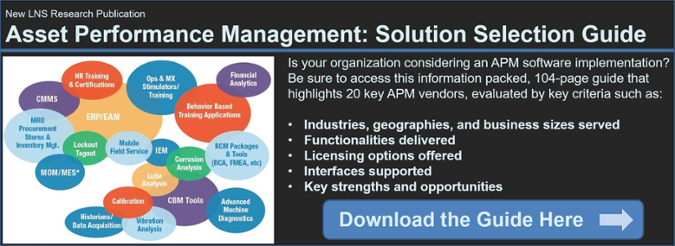2016 Asset Performance Management Predictions in Review: How Did We Do?
LNS Research Analyst, Jason Kasper, reviews the predictions made in the APM space for the year 2016 to see how they have measured up.
As asset performance has become an increasingly important aspect of manufacturing profitability, companies are rushing to adopt progressive maintenance practices. Predictive, Condition-Based, and Reliability-Centered maintenance are now among the topics trending on the web.
While advanced asset performance management practices are commendable you need to remember two important points. First: Power tools require a certain level of maturity before you should use them--you would not let a five year old use a chain saw. And second: Not every piece of equipment needs the same level of sophistication when it comes to maintenance--just because you have a hammer not everything is a nail.
In this post, we'll inspect different APM maturity models and the importance of understanding them further.
Some say we progress from infancy through youth to adult stages in life. Others offer a more granular model of our lives starting with conception followed by birth, infancy, childhood, adolescence, adulthood, and finally the senior or golden years. Both groupings are correct and are simply just representations of the stages of maturity we have. We refer to these as models of maturity.
Like humans, organizations pass through stages as well. The overall culture or character of an organization as well as individual processes that are practiced within an organization pass through different stages. When trying to characterize how sophisticated or accomplished an organization is at performing certain processes it often refers to its maturity level.
Just as there are many ways to describe an individual’s maturity there many models on how to describe the maturity of an organization or its ability to use a specific process methodology. None are “better” than others, but some are more widely adopted.
Researchers at Carnegie Mellon Universities Software Engineering Institute formulated one of the more widely adopted maturity models. They published a Capability Maturity Model which was promoted for use in process improvement, originally in software development and implementation, but since applied to virtually any process.
Like many terms that are registered trademarks, the term Capability Maturity Model (CMM) has become a widely used way to refer to any process maturity model.
The Carnegie Mellon CMM uses five levels of maturity:
Another five-level model, the Quality Management Maturity Grid was presented by Philip Crosby in his book “Quality is Free” and consists of the stages of Uncertainty, Awakening, Enlightenment, Wisdom, and Certainty. At LNS Research, we've developed our own Quality Management Maturity Model as well.
In the maintenance field, a common practice has been to characterize maintenance approaches as maturity levels such as Reactive, Preventative, Predictive, Condition-Based and Reliability-Centered.
While the idea of a simple five-level characterization of your maintenance approach starting with reactive and moving to RCM is attractive, you need to avoid it.
Maintenance approaches have evolved from the break-fix mode associated with reactionary, to more sophisticated approaches such as doing preventative maintenance based on either calendar hours or run-time, to various forms of predictive maintenance using tools like condition monitoring as well as performance monitoring and correlating machine condition to quality and throughput.
The reason you don’t want to equate these approaches with process maturity is that all of them may be very valid approaches for different types of equipment in the plant. Not all equipment requires the same approach. In fact, as one matures to become optimized it implies that each appropriate approach has been identified for every specific item maintained.
Think about your automobile. We tend to change light bulbs when they burn out--reactive maintenance. We change our oil every 7,500 miles or six months, which is preventative maintenance. We may use an antifreeze test strip to test the condition of the antifreeze, which is a form of predictive or condition-based maintenance. Another condition-based maintenance action would be to take the car in for service if we note the fuel economy declining or performance to be not quite as we expect.
Likewise, in manufacturing your approach to maintaining assets needs to be based on the criticality of the asset to the manufacturing process, the risk that failure represents to the process, and the costs of maintenance versus downtime. All approaches to maintenance have their usefulness depending on the specifics of your manufacturing process.
Investing in CBM or RCM is certainly appropriate for critical assets that have high cost of associated downtime, but for other assets a preventive approach may be more cost-effective. When you recognize the difference and adopt the right approach for each asset you are on your way to having a more mature APM process.
We'll be writing more about the optimial approach to maintanance and maturity in the near future, but in the meantime, feel free to take our mini survey on different approaches to APM. All participants will receive the results once the survey closes.
Understand the capabilities of twenty of the leading vendors in the APM space by downloading our APM Solutions Section Guide. The guide contains comparison charts for the factors listed above and the detailed profiles of the twenty vendors ranging from automation companies, to enterprise software providers and includes many specialized APM solutions as well.
As a member-level partner of LNS Research, you will receive our expert and proven Advisory Services. These exclusive benefits give your team:
Let us help you with key decisions based on our solid research methodology and vast industrial experience.
BOOK A STRATEGY CALLLNS Research Analyst, Jason Kasper, reviews the predictions made in the APM space for the year 2016 to see how they have measured up.
Learn why sometimes too much asset performance management (APM) automation can be a bad thing.
Learn about the differences between preventative maintenance and predictive maintenance.
The Industrial Transformation and Operational Excellence Blog is an informal environment for our analysts to share thoughts and insights on a range of technology and business topics.